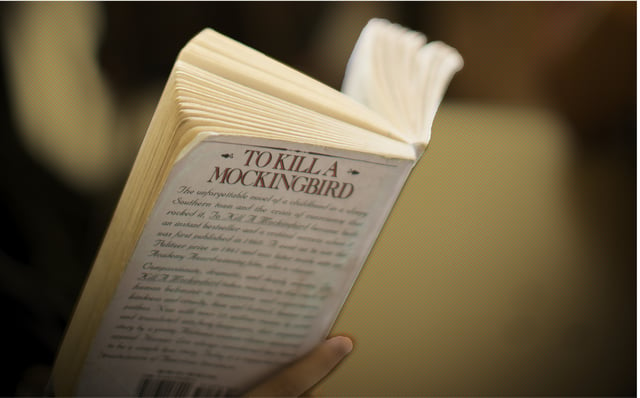
As a high school English teacher, my goal is to produce globally aware students who see the larger context of the curricula we are studying. Texts, such as Harper Lee’s To Kill a Mockingbird, are valuable lenses to educate my students about what it means to be humane, active participants in their classroom and the world. Before attending Facing History’s Teaching Mockingbird seminar, I thought about how to approach the novel in a way that would encourage my pupils to explore the complexity of human behavior and decision-making. But I was also looking to be inspired about how to most effectively end my semester-long unit on Race and Membership using the novel. Now, I have a plethora of strategies to discuss the dilemmas that develop when conscience comes into conflict with societal rules of behavior.
My freshmen and I spend the first 12 weeks of the year examining complex questions in the context of our own lives as well as in the lives of several characters, including: What does it mean to be “fit” or “unfit” in society? Who decides? What happens when people accept the idea that some people are not fit to be members of society? I envisioned approaching To Kill a Mockingbird in a similar fashion, highlighting several individuals who do not fit into Maycomb’s strict societal expectations and how this affects their lives.
Here are four major take-aways I’ll incorporate into my classroom after taking the Teaching Mockingbird seminar:
- Stimulate Authentic Conversations through Activities: Jigsaw readings, identity charts, close readings, and close viewings can help explore the social pressures on characters in Maycomb county. This can lead to rich discussions about forces that shape our development and about how much of our identity we have the power to change. I felt particularly enlightened by the jigsaw activity on gender as a social construct, which was centered on Mayella Ewell, Atticus Finch, Aunt Alexandra, and Calpurnia. Often the 1930s is a distant, foreign past to my students, but with this curriculum, an assigned pairing of texts can illuminate personal and internal struggles. For example, Maya Angelou’s tearful reading of her poem, “The Mask,” melted away my impression of the stoic Calpurnia, and instead I saw her as vulnerable and protective of her dignity and true, authentic self. I saw the pain of straddling two worlds, two selves – the doting, loving black nanny who devotes herself to Jem and Scout and the pained, working mother who leaves her own family to raise another person’s white children.
- Use Relatable Examples: Cicada Scott’s winning essay from the 2016 Facing History student contest, “Congratulations! It’s a Mockingbird!” gives readers a real-life connection to Scout’s resistance to being categorized as lady. This heartfelt essay about how Cicada transcends gender and resists being consigned to a binary gender can serve as a model of self-reflection for my students. They can use this essay to continue the conversations they started at the beginning of the school year, drawing from the complexities of their own identity charts and pivotal moments in their lives.
- Make Connections to Today: Rather than ignore the applications of Tom Robinson’s trial to today’s events, I see that this unit can be a pivotal point, a perfect time to talk about Alton Sterling, Philando Castile, Michael Brown, Eric Garner, and Tamir Rice. This opens discussions about what happens and what to do when people in positions of authority, whether Presidential candidates, police officers, or role models, use language and, perhaps, even laws to disempower groups of people. I want to remind my students that even though it might be more comforting to think of Tom Robinson’s conviction as something that only happened “back then” and in the South, we, like our country, are still works-in-progress and we can be, and should be, part of the conversation. Liz Vogel, Director of Facing History, Los Angeles stated, as educators we can model civil discourse in the face of bigotry, bullying, and hate speech. We, too, are living in a time where this is incredibly important.
- Get Proximate: Thanks to the seminar, I also discovered the idea of ending the unit with the work of attorney, human rights activist, and author, Bryan Stevenson, especially his advice on the four ways to change the world. He encourages us to get proximate to the problems we care about, to change the narrative, to remain hopeful, and, sometimes, to do uncomfortable things.
I hope that this unit will inspire my students to be vulnerable and honest, and to have important conversations with others about issues that really matter. As Mr. Stevenson spoke about hope – the kind of hope that "will make you stand when everyone else is sitting . . . [and] make you speak when everyone else is silent" – I thought of how my students are my hope for a brighter tomorrow and the best reason to keep going, even when the world seems dark and the obstacles feel insurmountable.
Facing History offers resources and professional development on teaching To Kill a Mockingbird. Learn more, download the guide, and register today!


